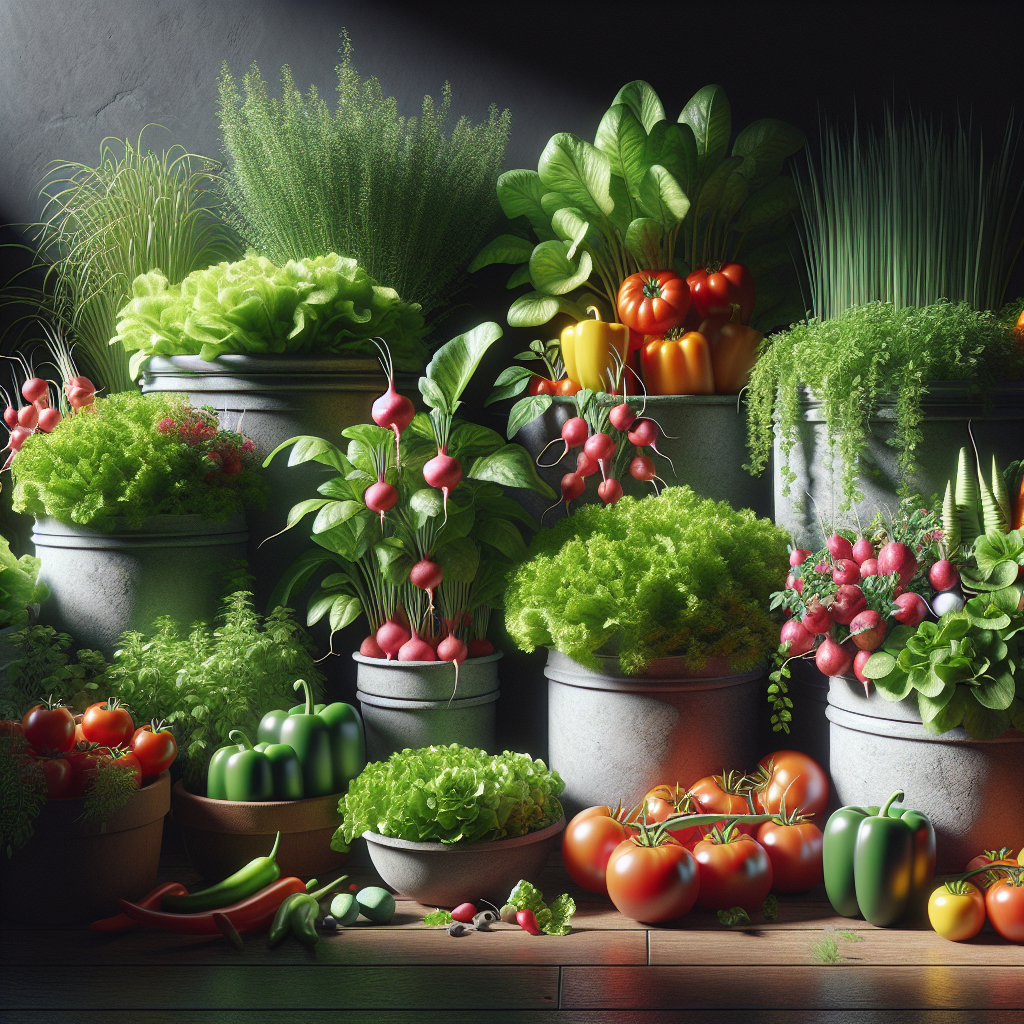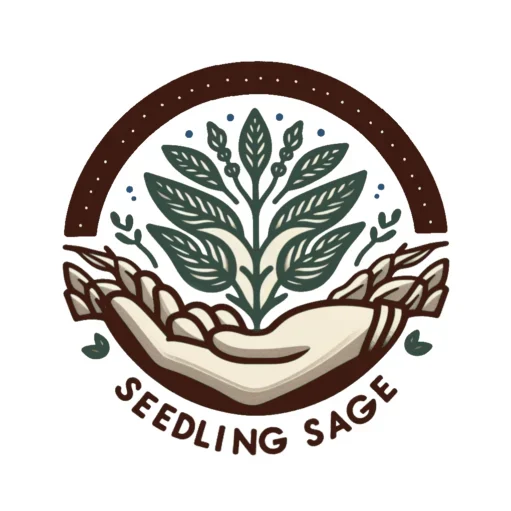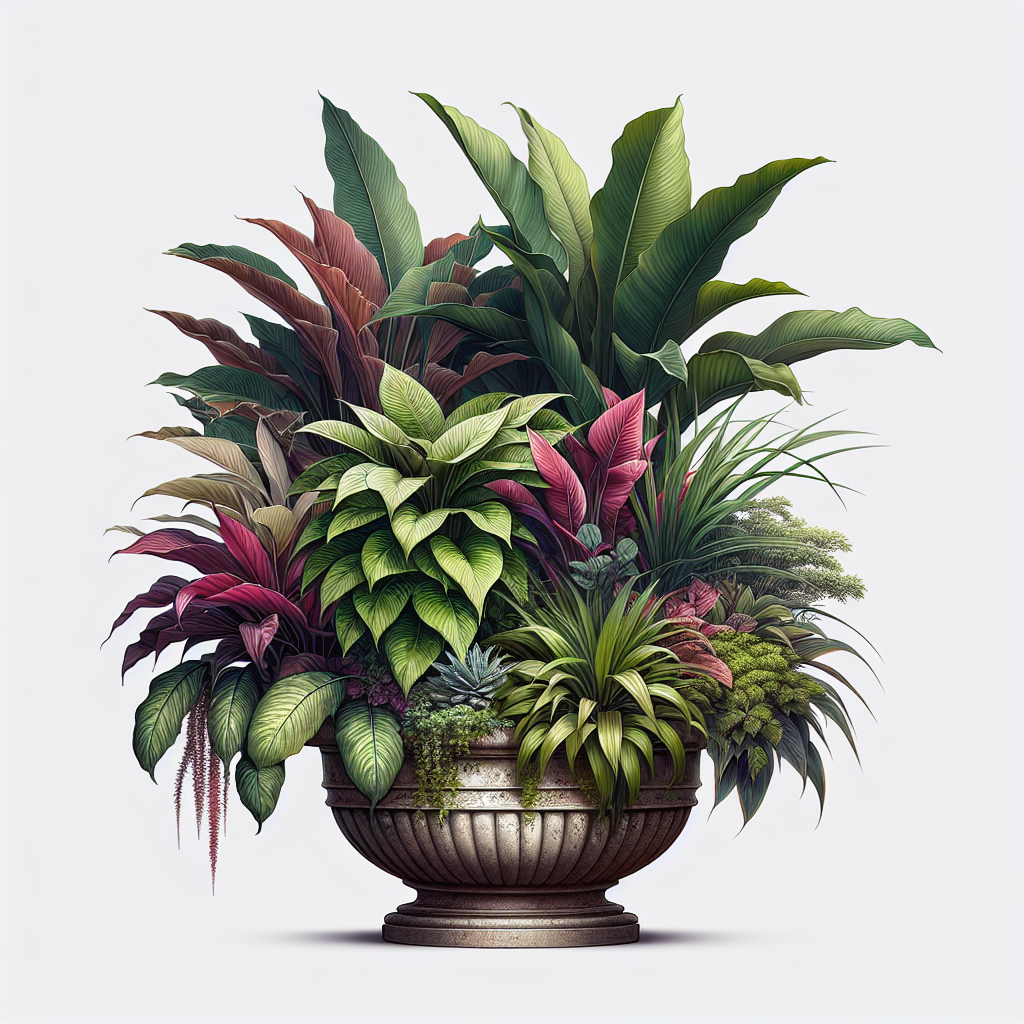Container Gardening Made Easy: Best Vegetables That Grow in Containers for Beginners
December 2, 2024 | by Emma Sage

VEGETABLES THAT GROW WELL IN CONTAINERS
11 min read
Discover vegetables that grow well in containers and transform your small space into a lush green paradise!
Choosing the Right Containers
Picking the perfect pot is like setting up the stage for a hit show—it’s the secret to winning the container gardening game, especially when veggies are the stars. By matching the container size to the plant and giving enough wiggle room for their growth spurt, I can create a blooming garden, even with the most cramped spaces.
Matching Size to Plant
When I’m on a mission to find containers for my veggies, I make sure there’s a perfect match between the size of the plant and the pot. It’s kinda like shoe-shopping; you want a snug fit for both the roots and the leafy top. Jam a big plant into a tiny pot, you risk stunting its growth just like squishing your toes in too-small sneakers. The wise folks at University of Maryland Extension suggest that picking the right pot is basically make-or-break for a veggie container garden.
Now, in my experience, pots made of clay can be thirstier than a marathon runner on a sunny day. They dry out fast, meaning I end up running for the watering can more often. So, I lean toward plastic, wood, or fabric pots. You’ve gotta try fabric bags—my veggies seem to throw a little party in there. Peas and pole beans? They can climb their way up a simple trellis in those pots like nobody’s business (Savvy Gardening).
Here’s a handy cheat sheet:
| Plant Type | Recommended Pot Diameter |
|---|---|
| Tomatoes | 15 inches or more |
| Peppers | 12-14 inches |
| Zucchini | 15-20 inches minimum |
| Herbs | 6-12 inches |
Importance of Adequate Space
Keeping the roots happy is like keeping your shoes dry on a rainy day—totally essential. Tiny garden spaces with limited soil mean watering becomes the name of the game. Ensuring enough space in the pot helps the soil stay moist and the plants grow strong, as noted by University of Maryland Extension.
Balconies, windowsills, tiny decks, they’re all spaces where containers just shine. I’ve placed pots on every kind of outdoor perch imaginable (Sprouted Garden). And don’t forget—most veggies would write a sonnet about the sun if they could. A good 8 hours of sunlight hits their sweet spot, so I always scout out the sunniest corner. Shade-loving plants? They’re my go-tos when shadows loom.
Larger veggie plants, like our friends tomatoes and zucchinis, seriously need some leg room, minimum of 15 inches across the pot. Happy roots, happy plants, happy me (Savvy Gardening).
Choosing just the right pot is like picking the perfect frame for a picture—it sets up my whole garden for stardom, letting veggies thrive in places you’d never expect.
Vegetables Thriving in Containers
Container gardening is my jam when it comes to growing fresh veggies in cramped spaces like balconies or cozy patios. Here’s a list of veggies I adore that just love life in containers.
Tomatoes, Peppers, Cucumbers
These guys are my go-to veggies for container garden vibes. Tomatoes are rockstars in pots and can give you a seriously impressive harvest. Peppers, with their easy-going nature, splash some serious color around too. I fill my containers with all kinds of pepper varieties, from sweet to downright fiery.
Cucumbers are another fab pick for container gardening. They love climbing up trellises or stakes, making them perfect for space-saving. The vines double as decorative pieces while serving up crunchy snacks.
| Vegetable | Container Size | Little Tips |
|---|---|---|
| Tomatoes | 5 gallons minimum | They need a bit of support |
| Peppers | 2-3 gallons | Sunlit spots make ’em happy |
| Cucumbers | 5-7 gallons | Trellises help ’em reach high |
Zucchini, Radishes, Lettuces
Zucchini is another veggie that absolutely lives it up in containers. One plant churns out a whole lot of these beauties, perfect for my summer cooking.
Radishes are cool by me since they grow super fast. I throw them in containers and in what seems like no time, boom, fresh and crispy.
Lettuces and salad greens are my container champions. I plant all sorts of lettuce in little pots, so I always have fresh leaves ready for the dinner table.
| Vegetable | Container Size | Harvest Countdown |
|---|---|---|
| Zucchini | 5-10 gallons | 50-70 days |
| Radishes | 1-2 gallons | 25-30 days |
| Lettuces | 1-2 gallons | 30-60 days |
Different Soil Requirements
Most veggies and herbs are all about that container life. But, they might ask for a little extra food since they can’t pull nutrients from the ground as easily. I’ve picked up that using top-notch potting mix is key for their green goodness.
Keeping the drainage on point is a must to dodge overwatering. Each veggie might have different soil needs, but giving them nutrient-rich soil sets them up for a bumper crop.
Curious to learn more about specific plant types? Check out our guides on herbs for container gardening or drought-tolerant container plants.

Benefits of Container Gardening
Limited Outdoor Space
Container gardening is like a dream come true when I don’t have sprawling backyard real estate. Living in the city, cozy apartment, or with a teeny yard? No problem. I just grab some containers and plant away! I pop them on sunny spots—balconies, patios, or even window sills. They let me grow my own veggies and herbs without needing a huge plot. Plus, it’s all about being sustainable these days. If you’re in a pickle about plant choices, check out options like shade-loving plants for containers or drought-tolerant container plants.
| Container Location | Potential Vegetables |
|---|---|
| Balcony | Tomatoes, Peppers |
| Porch | Lettuce, Herbs |
| Windowsill | Radishes, Spinach |
Better Environmental Control
Here’s the kicker with container gardening: I get to play Mother Nature in my own home. Traditional garden beds? Who needs ’em when I can just shift my pots around to catch the right sunlight or avoid extra shade. If one spot isn’t working out—too much sun or not enough—I just slide things over to a better location. And when it’s about watering, I’m in charge. Dry spells? Extra watering. Storm brewing? Bring those pots inside or place them somewhere safe (Sprouted Garden).
Suitable for Various Abilities
Container gardening is amazing because everyone can join in the fun, no matter what physical challenges they might face. Like, I’ve seen how awesome it is for folks dealing with back problems, mobility issues, or those using wheelchairs. Setting up plants at a comfy height makes a huge difference. No more bending over—it’s just pure joy and relaxation gardening should bring. For more ideas, think about herbs for container gardening or spicing it up with cool tropical plants for containers.
Container gardening ain’t just about munching on home-grown goodies. It’s a way of gardening that’s as flexible and personal as I want it to be.
Soil Mix and Customization
Creating the perfect dirt cocktail for my plant pots is one of the funnest things I do in the garden. Good soil is like the secret sauce for making veggies flourish. Here’s my go-to strategy for mixing dirt that keeps my container-grown veggies happy as clams.
DIY Soil Mix Ingredients
I like playing mad scientist and mix up my own soil potion with these goodies:
| Ingredient | What It Does |
|---|---|
| Potting Soil | Sets the stage with decent drainage |
| Compost | Packs a nutrient punch and fluffs it up |
| Peat Moss | Keeps it nice and moist |
| Perlite | Stops soggy messes with extra drainage |
| Plant-tone | Feeds plants the good stuff |
This magic mix does a bang-up job of nourishing my plants, letting water flow just right, and warding off nasty bugs. Wanna geek out more on this? Peep the details at Sprouted Garden.
Nutrient-Rich Soil for Plants
Different veggies like different dirt vibes. Your tomatoes and peppers are loving the slightly sour soil with a pH swinging between 6.2 and 6.8. Herbs? They’re chill with it about neutral, around 7.0 (EarthBox). So, I’m always checking my dirt’s pH, tweaking it to make the plants feel at home. Happy plants grow better, right?
Soil Replenishment
Most potting mixes wear out around six months. I give mine a refresh every year or two—that peat moss gets cranky, and nutrients go poof! (EarthBox). When sprucing up the soil, I sprinkle in some dolomite for a nutrient boost. Some fancy garden boxes like EarthBox can keep on using the same mix for ages, as long as plant plagues don’t crash the party.
Mixing up a good soil and keeping it fresh ups my chances of garden glory. Whether I’m nurturing my veggies or pampering my herb buddies, killer soil is the foundation of a happy garden.
Sunlight and Container Placement
Sunlight Requirement
I’ve been on this wild adventure—learning that the amount of sunlight my plants soak up can make or break their ability to grow and sparkle with life. Our leafy friends like vegetables and herbs are kind of like sunbathers, craving a solid 8 hours of basking to show their best side. If they don’t get their daily dose, I’ve been known to find some results a bit underwhelming—less harvest, cranky plants, you name it. So, grabbing that sun-soaked spot is my mission when I’m settling my container crops. But if life’s got me stuck in the shadows, I turn my attention to shade-loving plants for containers, turning dimness into an opportunity.
Here’s a handy cheat sheet of light needs for my usual plant family faves:
| Vegetable | Sunlight Requirement |
|---|---|
| Tomatoes | 6-8 hours |
| Peppers | 6-8 hours |
| Cucumbers | 6-8 hours |
| Zucchini | 6-8 hours |
| Radishes | 6-8 hours |
| Lettuce | 4-6 hours (part shade) |
When I’m dealing with big players like tomatoes, zucchini, or those spud-tastic potatoes, I give them their comfy space with pots at least 15 inches wide. They need that elbow room for their roots (Savvy Gardening).
Positioning for Healthy Plants
Finding the right hangout spot for my containers is like setting up the stage for a plant party—it’s all in the spotlight. I hunt down nooks basking in the most sun during the day. Some container materials are more like camels, drying out fast, especially the porous ones like clay. So, I often go for plastic, wood, or even snazzy fabric containers to keep things cool and hydrated (Savvy Gardening).
While I’m lining up my containers, I keep a few tricks up my sleeve:
- Height: Tall guys at the back, short fellas at the front. It’s the only way the littles don’t get lost in the shadows.
- Mobility: If I’m in a rearranging mood or chasing the sun, I pick lightweight or rolling stand options. Gotta keep it flexible!
- Watering Needs: I sort the thirsty from the chill, grouping drought-tolerant plants with their low-maintenance friends (drought-tolerant container plants).
By eyeballing the right sunlight and smartly arranging my plants, I’ve built a cozy little garden haven, even in tiny spaces. When I’m itching for more green companionship, I dabble in various herbs for container gardening and other curious plants that slot seamlessly into my leafy lineup.
Container Characteristics
Picking the right pot can be a game changer in gardening, especially when growing veggies in tight spots. The pots you choose basically set the stage for how well your plants will thrive!
Impact on Plant Growth
It’s like this: the bigger the pot, the better the soil holds water, meaning less time spent with the hose. For the big guys—think tomatoes and zucchinis—you’re going to want pots about 15 inches wide. This lets their roots spread out nicely so they can soak up all that good stuff they need.
| Vegetable Type | Recommended Pot Size |
|---|---|
| Small crops (radishes, lettuces) | 8-10 inches |
| Medium crops (peppers, herbs) | 12-15 inches |
| Larger crops (tomatoes, zucchinis) | 15-20 inches |
Porous vs. Non-Porous Materials
For keeping plants happy, what your pot’s made of can count, too. I learned pretty quick that clay pots dry things out fast, which is a pain for plants that are thirsty. I lean towards plastic, wood, or those trendy fabric pots—they keep moisture better and take less babysitting. Fabric pots have made quite the splash lately, especially with climbers like peas and pole beans using a simple trellis to shoot up sky high.
Size and Maintenance Requirements
A bigger pot usually means less work for you. I can water less often, unlike with smaller pots that dry out in a flash. The pot material’s also key—some dry out faster than others, telling you how much TLC you’ll need to give.
And don’t even get me started on soil. The cheap stuff can choke your plant babies with poor drainage. Go for the good quality potting soil, and your veggies will seriously thank you.
Getting these pot choices down lets me have a blooming, bustling garden on my tiny balcony. If you’re curious about what plants work well in pots, check out our tips on herbs for container gardening, or find ideas for shade-loving plants for containers.
Happy Gardening,
Emma Sage
RELATED POSTS
View all



